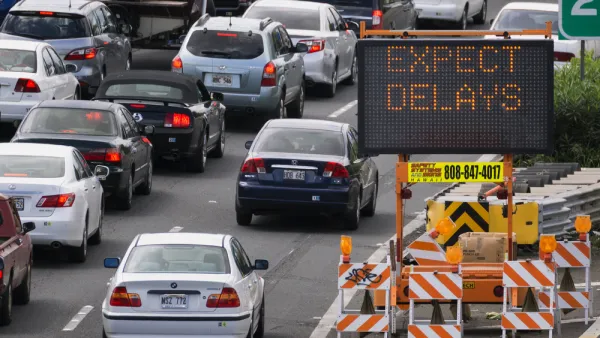Induced traffic occurs when new highway capacity speeds up traffic, allowing travelers to drive further, increasing sprawl. A review of major highway project plans finds that most fail to accurately account for induced travel effects.

The problem of induced traffic, aka induced demand, is well-documented in the literature. Yet it is too rarely accounted for in practice. A new paper by Jamey M.B. Volker (University of California-Davis) and co-authors examines the environmental documents from five major highway projects to see how they addressed induced traffic. The results: not well.
Induced traffic occurs when new highway capacity speeds up traffic, allowing travelers to drive further and land uses to spread out. These rebound effects eventually reduce travel speeds again, leaving travelers with longer trips in congested conditions. Failing to account for induced traffic makes highway capacity projects look much more beneficial than they really are.
Unfortunately, the environmental documents from the five projects reviewed in the paper generally ignored induced traffic except when prompted by public comment. Even then, discussion of the problem was sometimes internally inconsistent and failed to reflect findings from the literature. In three of the five cases, environmental documents did make an estimate of induced traffic, but these estimates were much less than the literature would suggest—and in two cases by orders of magnitude.
The paper points to reliance on demand models as an important source of bias in induced traffic estimates:
Current travel demand models do not fully account for induced vehicle travel, as detailed by Milam et al. (6) and Litman (15). The issue is that most models do not include all of the feedback loops necessary to represent the secondary effects of capacity expansion. These models were designed to estimate the effect of capacity expansion on travel times for a given population and employment level for the region. Many models now feed the estimated travel times back into the mode split stage of the model, thereby accounting for potential shifts away from transit and active modes resulting from improved travel times. Few models feed the estimated travel times back into the trip distribution or trip generation stages of the model, thereby ignoring the possibility that improved travel times will increase the number of trips that residents choose to make or the possibility that they will choose more distant destinations for their trips. Few models feed estimated travel times back into assumptions about the distribution and growth of population and employment that also influence the frequency and length of trips. In short, the models may do an adequate job of accounting for changes in route and shifts in mode, but they underestimate increases in VMT attributable to increases in trip frequencies and lengths that the capacity expansion will induce.
Induced traffic estimates can be improved by using lane-miles-to-VMT elasticities, such as those in the Induced Travel Calculator at UC-Davis, the paper suggests. The calculator’s estimates are based on areawide averages and may miss facility-specific conditions, but they can be used as default estimates or in combinations with other methodologies. The calculator is currently populated only with data from urbanized counties in California. But other states could readily develop their own calculators using available data.
FULL STORY: Induced Vehicle Travel in the Environmental Review Process

Analysis: Cybertruck Fatality Rate Far Exceeds That of Ford Pinto
The Tesla Cybertruck was recalled seven times last year.

National Parks Layoffs Will Cause Communities to Lose Billions
Thousands of essential park workers were laid off this week, just before the busy spring break season.

Retro-silient?: America’s First “Eco-burb,” The Woodlands Turns 50
A master-planned community north of Houston offers lessons on green infrastructure and resilient design, but falls short of its founder’s lofty affordability and walkability goals.

Test News Post 1
This is a summary

Analysis: Cybertruck Fatality Rate Far Exceeds That of Ford Pinto
The Tesla Cybertruck was recalled seven times last year.

Test News Headline 46
Test for the image on the front page.
Urban Design for Planners 1: Software Tools
This six-course series explores essential urban design concepts using open source software and equips planners with the tools they need to participate fully in the urban design process.
Planning for Universal Design
Learn the tools for implementing Universal Design in planning regulations.
EMC Planning Group, Inc.
Planetizen
Planetizen
Mpact (formerly Rail~Volution)
Great Falls Development Authority, Inc.
HUDs Office of Policy Development and Research
NYU Wagner Graduate School of Public Service




























